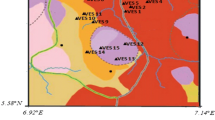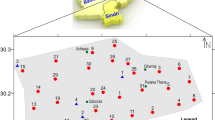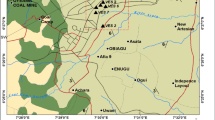Abstract
In order to manage groundwater resources and presenting appropriate management strategies, the value of acquiring Knowledge of groundwater flow and volume estimate is obvious. Particularly, since in IRAN due to its climate conditions (dry and semi-dry), water resources for agriculture is strongly linked to groundwater resources. In this regard, vertical sounding with Schlumberger array is the most common and most useful geophysical method in groundwater exploration studies. In this study, to evaluate the Roniz aquifer located in 160 km south East of Shiraz, 97 electerical sounding was implanted. Field data in view of the log wells and area geological data was processed and interpretated by IPI2Win software and with its help the depth and Subsurface layers thickness in area was determined. Acquired Results from interpretation of sounding curves in the region shows four to five main layers, Which contains a dry alluvial layer average with electric resistance of 200 Ω-m and an average thickness of 20–60 m, Sandstone layer with electrical resistance of 340 Ω-m and an average thickness of between 10 and 15 m, Marl layer with electrical resistance 20–41 Ω-m and thickness of 20–30 m, Aquifer (lime) layer with the electrical resistance of 0.4–6 Ω m and a thickness of between 6 and 8 m, and lime stone floor from a depth of about 150 m down. In addition that with the help of these soundings, 13 wells were designed and are being exploited.











Similar content being viewed by others
Notes
Knowing the electrical conductivity And the use of fluid and solids mechanics, can let us to Determine The best place to Drill well without negative effects or any side effects on other wells, based on the electrical conductivity and the use of fluid and solids mechanics.
References
Alizadeh A (1999) Evaluation of experimental method in estimation of maximum instantaneous flood discharge. Adv Environ Biol 78–90
Amadi AN, Olasehinde PI, Okunlola IA, Okoye NO, Waziri S (2010) A multidisciplinary approach to subsurface characterization in Northwest of Minna, Niger State, Nigeria. Bayero J Phys Math Sci 3(1):74–83
Andrews ND, Aning AA, Danuor SK, Noye RM (2013) Geophysical investigations at the proposed site of the KNUST teaching Hospital building using the 2D and 3D resistivity imaging techniques. Int Res J Geol Min (IRJGM) 3(3):113–123
Aning AA, Tucholka P, Danuor SK (2013) The Bosumtwi Meteorite Impact Crater, Ghana: New Results on the impact direction of the meteorite from 2D Electrical Resistivity Tomography (ERT) Survey
Anomohanran O (2013a) Geophysical investigation of groundwater potential in Ukelegbe, Nigeria. J Appl Sci 13(1):119–125
Anomohanran O (2013b) Investigation of groundwater potential in some selected towns in Delta North
Ayolabi EA, Adeoti L, Oshinlaja NA, Adeosun IO, Idowu OI (2009) Seismic refraction and resisitivity studies of part of igbogbo township, South-West Nigeria. J Sci Res Dev 11:42–46
Binley A, Kemna A (2005) DC resistivity and induced polarization methods. In: Yuram R, Hubbard SS (eds) Hydrogeophysics. Water and science technology library, vol 50. Springer, New York, pp 129–156
Christensen NB, Sorensen KI (1998) Surface and borehole electric and electromagnetic methods for hydrogeological investigations. Eur J Environ Eng Geophys 3:75–90
Dahlin T (1996) 2D resistivity surveying for environmental and engineering applications. First Break 14:275–283
Dept. of Geo-Physics (2002) Moscow State University, IPI2Win (MT) v.2.0 users Guide, Geo Scan-M ltd
District of Nigeria. Int J Appl Sci Technol 3(6):61–66
Dobrin MB, Savit CH (1988) Introduction to geophysical prospecting, 4th edn. Mc Graw-Hill, New York, p 245
Ernstson K, Kirsch R (2006) Geoelectrical methods, basic principles. In: Kirsch R (ed) Groundwater geophysics: a tool for hydrology. Springer, New York, pp 85–108
Kearey P, Brooks M (2003) An introduction to geophysical exploration. Blackwell Scientific Publications, Hoboken
Kurniawan ALVA (2009) Basic principles in using IP2 Win Software
Lapenna V, Lorenzo P, Perrone A, Piscitelli S, Rizzo E, Sdao F (2005) 2D electrical resistivity imaging of some complex landslides in the lucanianapennine chain, Southern Italy. Geophysics 70(3):90–101
Loke MH (2000) Electrical-imaging surveys for environmental and engineering studies, a practical guide to 2-D and 3-D surveys
Lowrie W (1997) Fundamental of geophysics. Cambridge University Press, Cambridge, p 254
Ozegin KO, Oseghale A, Okolie EC, Ujuanbi O (2011) Integration of very low-frequency electromagnetic (VLF-EM) and electrical resistivity methods in mapping sub-surface geologic structures favourable to road failures. Int J Water Res Environ Eng 3(6):126–131
Scollar I, Tabbagh A, Hesse A, Herzog I (1990) Archaeological Prospecting and Remote Sensing. pp 674
Siddiqui FI, Osman SBABS (2012) Integrating geo-electrical and geotechnical data for soil characterization. Int J Appl Phys Math 2(2):97–104
Sorensen KI, Auken E, Christensen NB, Pellerin L (2005) An integrated approach for hydrogeophysical investigations: new technologies and a case history. In: Butler DK (ed) Near-surface geophysics 2, investigations in geophysics, vol 13. Society of Exploration Geophysics, Tulsa, pp 585–603
Szalai S, Szarka L (2008) On the classification of surface geoelectric arrays. Geophys Prospect 56:159175
Tahmasbinejad H (2009) Geoelectric investigation of the aquifer characteristics and groundwater potential in Behbahan Azad University Farm, Khuzestan Province, Iran. J Appl Sci 9(20):36913698
Telford WM, Geldart LP, Sheriff RE (1990) Applied geophysics. Cambridge University Press, Cambridge, p 522
van Overmeeren RA, Ritsema IL (1988) Continouos vertical electrical sounding. First Break 6:313–324
Ward SH (1990) Resistivity and induced polarization methods. In: Ward SH (ed) Geotechnical and environmental geophysics 1, investigations in geophysics, vol 5. Society of Exploration Geophysics, Tulsa, pp 147–189
Author information
Authors and Affiliations
Corresponding author
Additional information
Publisher's Note
Springer Nature remains neutral with regard to jurisdictional claims in published maps and institutional affiliations.
Rights and permissions
About this article
Cite this article
Ghalamkari, S., Asadi, A., Pourkermani, M. et al. Geoelectric assessment of groundwater aquifers at RONIZ area, Southeastern SHIRAZ, IRAN. Geomech. Geophys. Geo-energ. Geo-resour. 5, 425–436 (2019). https://doi.org/10.1007/s40948-019-00121-4
Received:
Accepted:
Published:
Issue Date:
DOI: https://doi.org/10.1007/s40948-019-00121-4




